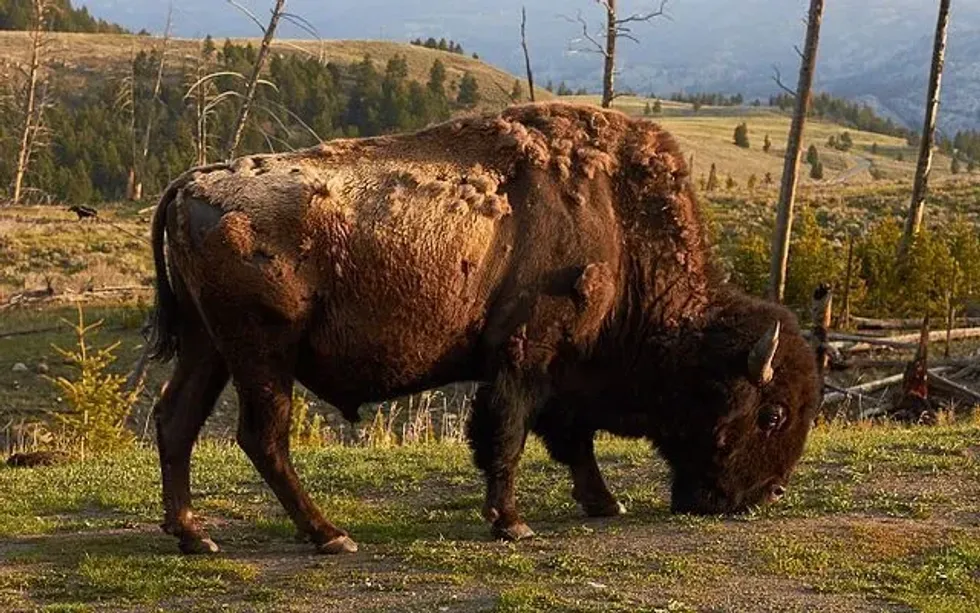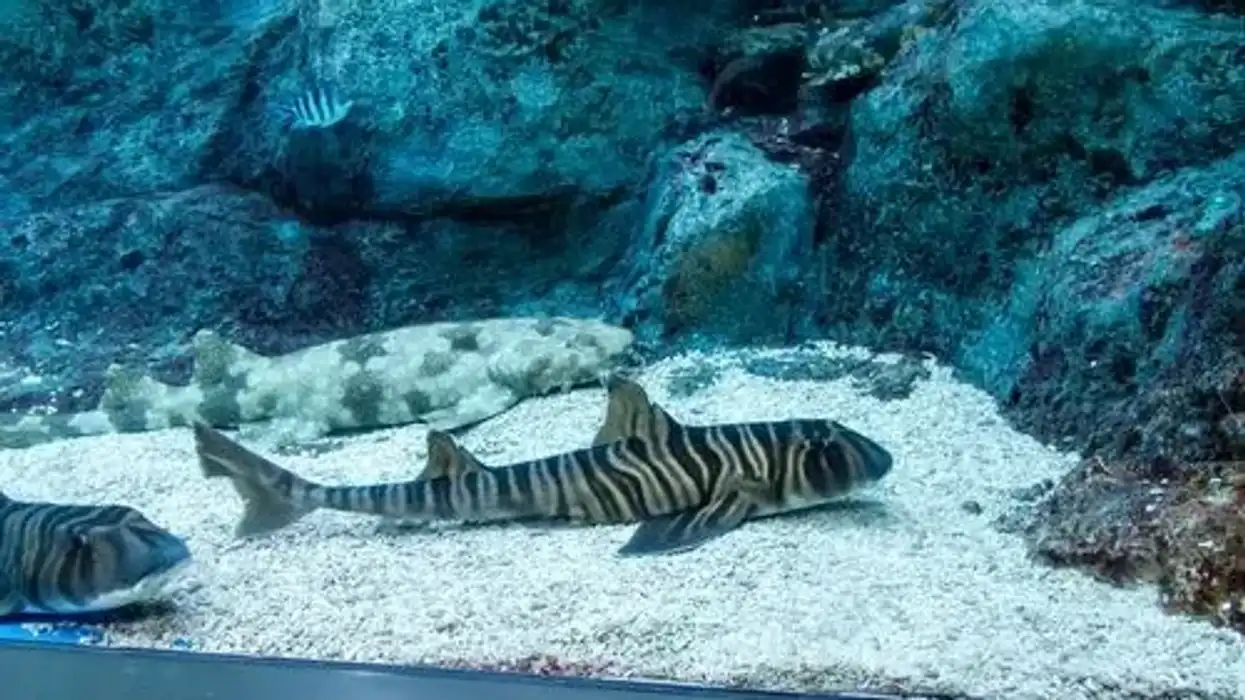The American bison is a large mammal that has roamed around the prairie lands of the west since prehistoric times. The American bison scientific name is Bison bison.
They are sometimes mistakenly called American buffaloes, but they differ from each other. Bison are more closely related to cows and bulls.
The American bison is the largest and the heaviest terrestrial animal found in North America. A gigantic American bison herd presumably roamed around the prairie lands between the Appalachian Mountains and the Rocky Mountains and the Great Plains of North America for centuries.
In the 19th century, millions of these bison were hunted and killed by Native American settlers. By the late 1800s, the American bison population was wiped off in large numbers and the species came to the brink of extinction.
Less than 1000 individuals survived including all the herds in the wild as well as captivity during that time. Since then, the conservation of the American bison has been a national priority.
They are preserved in many states like Oklahoma, Missouri, Illinois, North Dakota, and South Dakota as well as in national parks like Yellowstone National Park.
The American bison is one of the greatest conservation success stories in America. To know more about the bison, keep on reading these American bison facts for kids.
For similar content keep on reading bison and plain bison facts too.
American Bison Interesting Facts
What type of animal is an American bison?
The American bison or bison are a type of large and hefty North American bison that are native to the public lands of the United States, Mexico, and Canada in North America.
What class of animal does an American bison belong to?
The American bison of Artiodactyla order and Bovidae family belong to the class of mammals or Mammalia, the common class for all warm-blooded animals.
How many American bison's are there in the world?
The global American bison population is estimated to be around 31,000 individuals including adults and young calves. Bison are distributed in 68 conservation herds found across their range.
Each and every bison herd is preserved by the state and several other environmental organizations. A total of 20,000 individuals are found in the American plains while the remaining 11,000 are conserved in the woods. The total population of calves and juveniles varies from one year to another.
This makes it difficult to estimate actual adult bison populations. There is no accurate estimation of the total number of adult bison in a herd, it is believed to range between 11,248-13,123 individuals.
Elaborate researches have successfully concluded that most of bison herds consist of 30-40% calves. Once abundant bisons reached near extinction in the 1800s due to recreational and subsistence hunting throughout the bison range.
However, vigorous conservation measures have succeeded in recovering a part of the wildlife species of the west. Current threats to bison herds include habitat loss, illegal hunting and trapping, modification of their native lands, and invasion of other species and diseases.
Where does an American bison live?
The original American bison range extended from north Alaska to Mexico. American bison are divided into two types based on their habitat selection, the plains bison and the wood bison.
The range of the plains bison extended throughout the public lands of northern Mexico up to Alberta and Canada. The wood bison was found from Alaska to Canada and the United States.
At present, bison herds occupy only 1.2% of their original range in their actual habitat, the rest of them live in captivity. They are also found in Idaho, California, Oklahoma, South Dakota, and Montana.
The ecology of these animals is protected by several national wildlife policies in the North American range. They are preserved in few national parks of America in herds including the Yellowstone National Park and Wood Buffalo Park.
What is an American bison's habitat?
A traditional American bison habitat includes prairie grasslands, meadows, and open savannas. They are large mammals and can adapt to the largest range of natural habitats in North America. They range from dry arid regions to snowy cold regions. Currently, they are found in large numbers in conserved areas. They also reside in many national parks.
Who do American bison live with?
They are extremely gregarious in nature, they live in social herds containing a large number of bison. There are some factors that affect the selection process of the herd. They are American bison habitats, age, sex, and size.
Social hierarchy is existent in each and every bison herd. The females form an all females group with calves below three years of age. Male bison either live in groups or alone. A group of male bison can consist of up to 30 individuals.
They join cows only during the mating season. While feeding on grasslands and prairie lands, the bison is often observed to travel in a group by forming a line. They feed in loose groups.
How long does an American bison live?
The American bison lifespan varies from that of captivity. In the wild, these bison can live up to 15 years of old while the captive species have a much higher lifespan. They can live up to 25 years of old.
How do they reproduce?
The breeding season of the American bison lasts for a short while, starting in August and ends in September. The calving season automatically starts from mid-April.
There's one dominant bull present in each herd and it forms a harem of females for mating. The male bison produces a loud roar to attract the females of the harem. The other bulls of the herd tend the cows and drive away other competing males away from the females.
They follow the females around until they get a chance to mate with the females. They also cover the eyesight of the females during this time so that they can't catch a glimpse of the other competing males.
The dominant male bison completes the mating process by the first two to three weeks of the mating season. After the female and the male bison mate, the males have no other role in the mating season.
The female bison gives birth to a calf after a gestation period of 285 days.
A calf is nursed for at least seven to eight months and if the female is not pregnant, the calves are nursed for 18 months. The calf reaches sexual maturity at three years old but male bison do not mate until they turn six years old.
What is their conservation status?
According to the International Union for Conservation of Nature or the IUCN, the American bison or bison of the Bovidae family of bulls and cows are classified as a Near Threatened species in the Red List. American bison became extremely rare since the later years of the 19th century.
They were largely exploited at the hands of Native Americans who killed these mammals as a source of food as well as for recreational purposes. That era marked a near extinction status of these prehistoric animals that roamed the American prairie plains for years in large herds.
Due to American bison hunting and poaching, their populations became very unstable. After this incident, bison have been given the Near Threatened status.
American bison extinction was a huge blow to the iconic Native American bison history. Since then, the government and several other environmental organizations have stepped in to save and recover the population of this historic wildlife of North America.
Numerous conservation measures were drawn which ensured protection and ecological restoration of prairie for these animals.
Since the recovery of the national wildlife, they have become conservation-dependent animals. Even though they follow a stable trend as of yet, the likelihood of the mammal to grow in the future depends on the conservation interventions.
American Bison Fun facts
What do American bisons look like?
An American bison is the largest mammal, even bigger than moose, that roam around the North American prairie. Not only that, but they are also the heaviest among all.
The winter coat of the bison is shaggy and long and it is dark brown in color. In summer, they have a much lighter light brown coat.
The body hairs are longer towards the head of the bison and it becomes short when reaching the back. However, this distinction is not noticed much in a bull. The American bison skull structure and its shoulder hump are the most distinct characteristic features of a bison.
The horns have a sharp pointy end. Both the horns and the hooves of a bison are black in color.
How cute are they?
A bison appears like a beast to humans rather than cute.
How do they communicate?
A bison communicates in many ways. It primarily communicates by grunts and snorts but their excellent olfactory sense helps them in detecting danger. They also have great auditory senses.
How big is an American bison?
The American bison size ranges between 7-12.5 ft (2.1-3.8 m). They are only few feet smaller than the largest animals, elephants.
How fast can an American bison run?
American bison can gallop at very high speeds. They can reach speeds up to 34 mph (54.7 kph) while running. They are two times slower than pronghorns.
How much does an American bison weigh?
An American bison is one of the heaviest mammals that can weigh up to 2,000 lb (907 kg).
What are the male and female names of the species?
Male and female bison are respectively known as bull and cow.
What would you call a baby American bison?
A baby bison is referred to as a calf.
What do they eat?
A bison is herbivorous in nature and they are full-time grazers. They primarily feed on prairie grass but they can also eat sagebrush.
Are they dangerous?
Although bison look dangerous, they do not cause any harm unless they are intrigued.
Would they make a good pet?
A bison is domesticated in many American households, mainly for commercial purposes. They make good and beneficial pets.
What states do bison live in?
The state of South Dakota holds the highest number of bison. They are also found in states like Montana, Oklahoma, North Dakota, Nebraska, and Canada.
Did you know...
The heaviest bison ever recorded weighed 2800 lb (1270 kg).
What is the difference between a bison and an American buffalo?
The terms 'buffalo' and 'bison' are used interchangeably while describing the mighty American buffalo, but bison and buffalo are not the same. The physical and structural characteristics of a bison differ completely from that of a buffalo even though they are of the same family.
A bison has a large hump while a buffalo lacks a shoulder hump. The bison has thick hair around the hump and a beard but all these features are absent in a buffalo. Their horn structure is also different.








